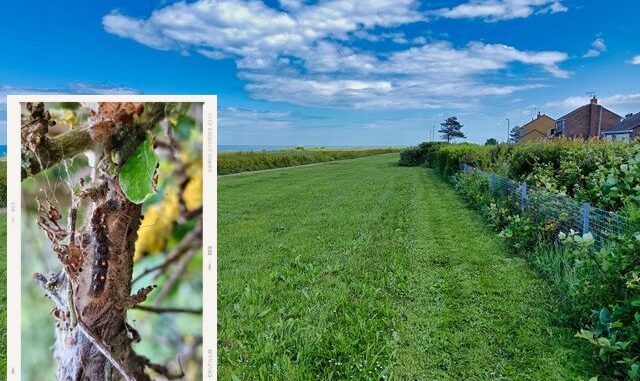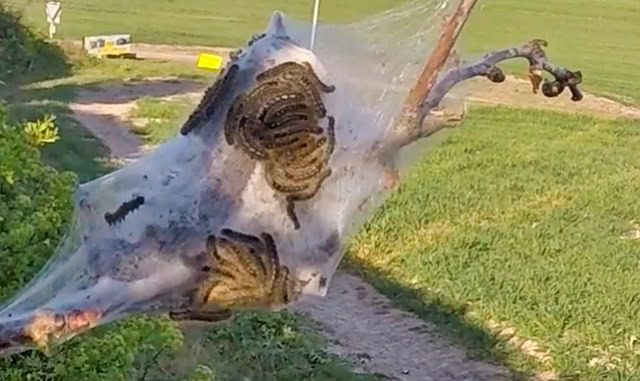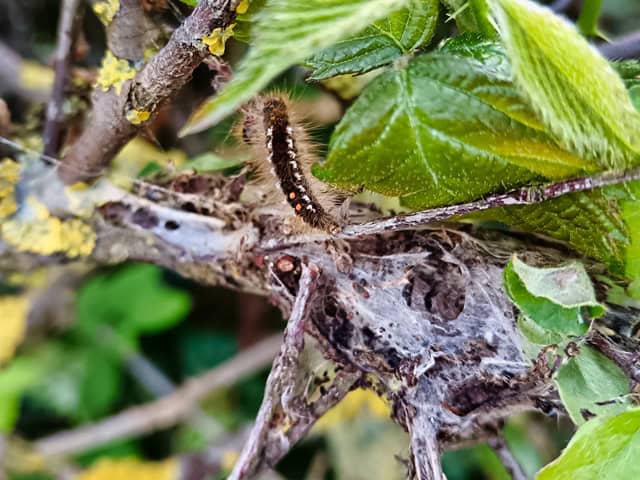
A request has been made to Kent County Council to install information signs to warn of ‘tent caterpillars’ in the hedgerow instead of a planned ‘targeted insecticide treatment.’
Cliftonville ward councillors Marc Rattigan, Barry Manners and Cedric Towning say use of harmful pesticides could be damaging to the eco-system at The Ridings which is a biodiversity area.
The tent caterpillars – larvae of brown tail moths – have hairs which can cause skin and eye irritations if people come into contact with them.
However, ward councillors and local nature enthusiast Nik Mitchell say the caterpillars are a vital part of the environment and natural food chain and point to the fact that they are by the biodiversity area.

A ward councillor statement says: “Tent caterpillars, despite their hairy appearance, do not pose a significant threat to humans or their host plants. In fact, they play a crucial role in the natural balance of the environment by providing a vital food source for wildlife.
“The use of harmful pesticides not only risks disrupting this delicate balance but also undermines the very goals of the district’s development. While some individuals may experience allergic reactions when in contact with the caterpillar’s hairs, there exist alternative measures that can be explored rather than resorting to their extermination.

“Environmental experts and concerned citizens propose a more thoughtful and effective solution – the installation of informative signage throughout the area. By implementing clear and visible signs, the public can be made aware of the presence of these caterpillars, enabling them to take necessary precautions to avoid any potential allergic reactions.
“This approach prioritises public safety while maintaining the ecological integrity of the district, aligning with its original purpose.
“We urge KCC to reconsider its current plan and embrace this alternative approach. By doing so, we can protect the area’s biodiversity, support pollinators, and ensure the safety and well-being of the community.
“Together, we have the opportunity to showcase Palm Bay as a shining example of sustainable development and responsible stewardship of our natural resources.”

Communication sent from KCC says targeted insecticide treatment is expected to begin on June 3 and letters will be sent to nearby residents to inform them.
A KCC spokesperson said: “There are several Brown Tail Moth sites within the highway hedge at The Ridings with active caterpillars. We are reviewing the site on a regular basis to determine how active the caterpillars are and what risk they present which will determine how they are controlled.
“Brown tail moths can be a serious risk to health. If the caterpillars come into contact with people, their hairs can cause a painful skin rash and can cause breathing difficulties.
“An inspection took place on 29 May to review activity. How these can be controlled will then be considered in consultation with local stakeholders to provide the safest, most proportionate solution.”
The Brown Tail Moth is an insect native to the UK. Adults are white with visible brown hairs on the end of their abdomen. The caterpillar is dark brown and has two distinct orange/red spots on its back towards the tail.
The caterpillars have small hairs on their bodies which break off easily and can irritate the skin which should be treated with warm, soapy water and calamine lotion. If the hairs get into the eyes or throat. a doctor should be seen.
Caterpillars eat the buds and leaves of trees and shrubs and create silken ‘tents’ attached to small branches. Each tent can contain up to 2000 caterpillars.
In late June the caterpillars pupate, turning into black chrysalides and by mid-July these hatch into adult moths.

